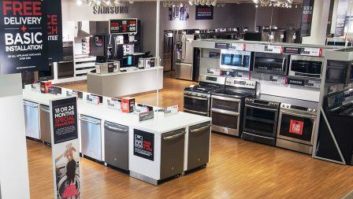Seoul, South Korea – U.S. consumers are largely unfamiliar with LG Electronics (LGE), but thanks to a major push by the Digital Appliance Co., the manufacturer’s major appliance division, that’s all about to change.
The South Korean conglomerate is already a major, albeit unknown, presence in American households through its Zenith electronics franchise, Goldstar small appliances, CD-ROM and DVD-ROM drives, and myriad brown and white goods contract manufactured for better-known brands.
But having established a dominant role in the Asian market for its own LG-branded appliances, the company has set its sights on North America, where it sees a land of opportunity for its sleek, high-tech and margin-rich refrigerators and laundry products.
U.S. retailers agree. In relatively short order following its U.S. introduction in 2001, LGE’s upper mid-tier appliance line has taken its place among Whirlpool, Maytag, Frigidaire and GE at Best Buy, and has become a presence at regional white goods powerhouses like Fry’s, H.H. Gregg and P.C. Richard & Son.
The result: a $50 million spike in U.S. revenue this year to some $280 million, on top of the approximately $500 million the company continues to enjoy in OEM sales, senior executives said.
To take the business to the next level and achieve its goal of becoming the No. 2 or No. 3 player in each of its product categories, LGE recently broke its first U.S. TV ad campaign promoting its new front-loading Tromm washers. The spot shows a little boy washing his linens in the middle of the night to conceal a bed-wetting incident, and introduces the tagline ‘Life’s Good’ — a play on the initials that originally stood for Lucky Goldstar.
At the same time, the company has embarked on an eight-city retail road show and training program; has begun shipping its first wave of side-by-sides to Best Buy; and is preparing a host of new introductions for the first half of 2004.
The latter include an updated version of its first-to-market Internet-enabled refrigerator, which reflects LGE’s heavy investment in networked home appliance systems. While the company concedes that it’s ahead of the demand curve for kitchen convergence, it envisions it as a key, if not commonplace, category in the not-to-distant future.
TWICE recently spoke with Michael Ahn, executive VP/digital appliance overseas marketing, at LGE’s global headquarters in Seoul, where he outlined the company’s game plan for the LG brand in North America. The discussion — which was briefly interrupted by his cell phone, which rang the tune ‘My Way’ — is excerpted below.
TWICE:Why America, and why now?
Michael Ahn: Our goal is to be among the top three appliance manufacturers worldwide by 2005. We’re sixth now, and could pass Matsushita and BSH next year.
We wanted to establish ourselves in Asia first. It’s a larger market, and we understand that culture better.
Until last year, we concentrated on the OEM business in the United States because our name is not known there and our sales network wasn’t strong. But we started the branded business by targeting the premium niche market, and are supporting it by establishing a service network, creating a distribution network, and making a big investment in supply chain management.
We’re still small in the U.S., but we’re growing fast. We also remain committed to the OEM business, which is a high volume area.
TWICE: How do you overcome the disadvantage of shipping major appliances from Asia?
Ahn: We produce our top-mount refrigerators and freezers at our facility in Mexico, but are shipping washing machines from Korea. If demand supports it, we could assemble additional products in Mexico.
TWICE: How will you compete in the crowded U.S. market against long-established brands?
Ahn: To attain market share, we must be better than our competitors. We achieve that through innovation, which is the application of technology to consumer needs. For example, to address limited space in kitchens, we’ve developed combination products like a microwave oven-and-toaster-in-one. We also supplied the halogen light, speed-cooking technology that allows our OEM customer to sell microwave ovens for as much as $1,000 when most typically retail for under $100.
We’ve also invested in networked home appliances, which we believe will be an important business sometime in the future. The timing was challenging — if we got in too early we fail, and if we enter too late we will follow rather than lead.
[Editors’ Note: Other innovations include the beltless, direct drive motor behind LGE’s front-loading Tromm washer, which has a 7 percent share of the Korean market; plasma-treated, water-repellent AC heat exchangers; and the novel linear compressor found in its refrigerators. All provide quieter operation and/or significant energy savings, the company says.]So even though the LG brand is almost unknown to U.S. consumers, they are buying our products because of their unique design and special technologies. Then they tell their neighbors about them because they are very satisfied with their purchases.
TWICE: Will you be entering additional categories besides refrigeration and laundry?
Ahn: We don’t want a complete appliance line because our resources for marketing, production and product development are limited. The U.S. market has many players, and if we want to be here long term and stay competitive, we’d rather be a substantial player in select categories than a big player in all of them.
So we’ve positioned ourselves as a high-end brand that’s similarly priced to Whirlpool, although Whirlpool doesn’t have the breadth of technologies behind it that we have.





